条形码
| 本条目可参照外語維基百科相應條目来扩充。 |
| 当前條目的内容正在依照其他语言维基百科的内容进行翻译。(2017年1月24日) 如果您熟知條目内容并擅长翻译,欢迎协助改善或校对此條目,长期闲置的非中文内容可能会被移除。 |
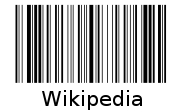

以可口可樂瓶子的曲線為條碼的造型
条形码或稱条码(barcode)是将宽度不等的多个黑条和空白,按照一定的编码规则排列,用以表达一组信息的图形标识符。常见的条形码是由反射率相差很大的黑条(简称条)和白条(简称空)排成的平行线图案。条形码可以标出物品的生产国、制造厂家、商品名称、生产日期、图书分类号、邮件起止地点、类别、日期等信息,因而在商品流通、图书管理、邮政管理、银行系统等许多领域都得到了广泛的应用。
目录
1 条码的识别原理
1.1 条形码的扫描
1.2 条码的优越性
2 条形码的发展歷史
3 條碼類型
3.1 線性條碼
3.2 矩陣(二維)條形碼
4 参考文献
5 外部連結
6 参见
条码的识别原理
要将按照一定规则编译出来的条形码转换成有意义的信息,需要经历扫描和译码两个过程。物体的颜色是由其反射光的类型决定的,白色物体能反射各种波长的可见光,黑色物体则吸收各种波长的可见光,所以当条形码扫描器光源发出的光在条形码上反射后,反射光照射到条码扫描器内部的光电转换器上,光电转换器根据强弱不同的反射光信号,转换成相应的电信号。根据原理的差异,扫描器可以分为光笔、CCD、激光三种。电信号输出到条码扫描器的放大电路增强信号之后,再送到整形电路将模拟信号转换成数字信号。白条、黑条的宽度不同,相应的电信号持续时间长短也不同。然后译码器通过测量脉冲数字电信号0、1的数目来判别条和空的数目,通过测量0、1信号持续的时间来判别条和空的宽度。此时所得到的数据仍然是杂乱无章的,要知道条形码所包含的信息,则需根据对应的编码规则(例如:EAN-8码),将条形符号换成相应的数字、字符信息。最后,由计算机系统进行数据处理与管理,物品的详细信息便被识别了。
条形码的扫描
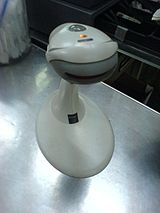
条形码扫描仪

掃描中的條碼
条形码的扫描需要扫描器,扫描器利用自身光源照射条形码,再利用光电转换器接受反射的光线,将反射光线的明暗转换成数字信号。不论是采取何种规则印制的条形码,都由静区、起始字符、数据字符与终止字符组成。有些条码在数据字符与终止字符之间还有校验字符。
- 静区:顾名思义,不携带任何信息的区域,起提示作用。
- 起始字符:第一位字符,具有特殊结构,当扫描器读取到该字符时,便开始正式读取代码了。
- 数据字符:条形码的主要内容。
- 校验字符:检验读取到的数据是否正确。不同编码规则可能会有不同的校验规则。
- 终止字符:最后一位字符,一样具有特殊结构,用于告知代码扫描完毕,同时还起到只是进行校验计算的作用。
为了方便双向扫描,起止字符具有不对称结构。因此扫描器扫描时可以自动对条码信息重新排列。
条码扫描器有光笔、CCD、激光三种:
- 光笔:最原始的扫描方式,需要手动移动光笔,并且光筆筆尖部分需要与条形码直接接触。
- CCD:以CCD作为光电转换器,LED作为发光光源的扫描器。在一定范围内,可以实现自动扫描。并且可以阅读各种材料、不平表面上的条码,成本也较为低廉。但是与激光式相比,扫描距离较短。
- 激光:以激光作为发光源的扫描器。又可分为线型、全角度等几种。
- 线型:多用于手持式扫描器,范围远,准确性高。
- 全角度:多为卧式,自动化程度高,在各种方向上都可以自动读取条码。
条码的优越性

可揭除的條碼
- 可靠性强。条形码的读取准确率远远超过人工记录,平均每15000个字符才会出现一个错误。
- 效率高。条形码的读取速度很快,相当于每秒40个字符。
- 成本低。与其它自动化识别技术相比较,条形码技术仅仅需要一小张贴纸和相对构造简单的光学扫描仪,成本相当低廉。
- 易于制作。条形码的编写很简单,制作也仅仅需要印刷,被称作为「可印刷的计算机语言」。
- 易于操作。条形码识别设备的构造简单,使用方便。
- 灵活实用。条形码符号可以手工键盘输入,也可以和有关设备组成识别系统实现自动化识别,还可和其他控制设备联系起来实现整个系统的自动化管理。
条形码的发展歷史
- 1949年美国人諾曼·伍德蘭[1](Norman Joseph Woodland)和伯纳德·西尔弗(Bernard Silver)申请了用于食品自动识别领域的环形条形码(公牛眼)。
- 1963年在1963年10月号《控制工程》杂志上刊登了描述各种条形码技术的文章。
- 1967年美国辛辛那提的一家KROGER超市首先使用条形码扫描器。
- 1969年比利时邮政业采用用荧光条形码表示信函投递点的邮政编码。
- 1970年美国成立UCC;美国邮政局采用长短形条形码表示信函的邮政编码。
- 1971年欧洲的一些图书馆采用Plessey码。
- 1972年美国人蒙那奇·马金(Monarch Marking)研制出库德巴码,同年交叉25码被开发出来。
- 1973年美国统一编码协会(简称UCC)在IBM公司的条码系统基础上建立了UPC码系统,并且实现了该码制标准化。
- 1974年美国Intermec公司的戴维·阿利尔(Davide·Allair)博士研制出39码。
- 1977年欧洲共同体在UPC-A码基础上制定出欧洲物品编码EAN-13码和EAN-8码,签署了「歐洲商品編碼」(European Article Number,簡稱EAN)协议备忘录,並且成立了欧洲物品编码协会。
- 1978年日本在EAN的基础上开发出JAN码。
- 1980年美国国防部采纳39码作为军事编码。
- 1981年欧洲物品编码协会改组为国际物品编码协会(IAN);实现自动识别的条形码译码技术;128码被推荐使用。
- 1982年手持式激光条形码扫描器实用化;美国军用标准military标准1189被采纳;93码开始使用。
- 1983年美国制定了ANSI标准MH10.8M,包括交叉25码、39码和库德巴码。
- 1987年美国人David Allairs博士提出49码。
- 1988年可见激光二极管研制成功;美国的Ted Willians提出适合激光系统识读的16K码。
- 2005年EAN更名為GS1。
條碼類型
線性條碼
第一代,“一维”的条码是由线条和空间的各种宽度,创建特定的模式。
| 例如 | 符號 | Continuous or discrete | 條紋寬度 | 用途 |
|---|---|---|---|---|
澳大利亞郵政條碼 | Discrete | 4 bar heights | 一個澳大利亞郵政條碼作為一個商業上的答复付費信封。 | |
| Codabar | Discrete | Two | 在圖書館和血庫和airbills使用的舊格式(過時) | |
| Code 25 – Non-interleaved 2 of 5 | Continuous | Two | 產業 | |
| Code 25 – Interleaved 2 of 5 | Continuous | Two | 批發,圖書館國際標準ISO / IEC 16390 | |
 | Code11 | Discrete | Two | 電話(過時) |
 | Farmacode or Code 32 | Discrete | Two | 意大利 Pharmacode 成為-使用代碼39 (無國際標準) |
 | Code39 | Discrete | Two | 其他 - 國際標準ISO / IEC 16388 |
 | Code49 | Continuous | Many | 各個 |
| 128px | Code93 | Continuous | Many | 各個 |
 | Code128 | Continuous | Many | 其他 - 國際標準ISO / IEC 15417 |
| CPC Binary | Discrete | Two | ||
 | DX film edge barcode | Neither | Tall/short | Color print film |
 | EAN 2 | Continuous | Many | 插件代碼(雜誌), GS1 -approved -不是自己的符號-要只用一個EAN / UPC根據ISO / IEC 15420使用 |
 | EAN 5 | Continuous | Many | 插件代碼(書), GS1 -approved -不是自己的符號-要只用一個EAN / UPC根據ISO / IEC 15420使用 |
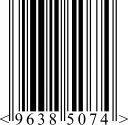 | EAN-8, 歐洲商品條碼 | Continuous | Many | 全球零售, GS1 -approved -國際標準ISO / IEC 15420 |
 | EAN-13, 歐洲商品條碼 | Continuous | Many | 全球零售, GS1 -approved -國際標準ISO / IEC 15420 |
| Facing Identification Mark | Discrete | Two | 美國郵政業務回復郵件 | |
| GS1-128(前身為UCC/ EAN-128),誤稱為EAN·UCC的128和128構僅僅是128碼(ISO/ IEC15417)的應用。 | Continuous | Many | 各種,GS1批准 - 只是應用程序代碼128(ISO/ IEC15417)使用和mh10.8.2 AI的數據結構它不是一個獨立的符號 | |
 | GS1的的 DataBar 的前身縮減碼(RSS) | Continuous | Many | 各種,GS1批准 |
| Intelligent Mail barcode | Discrete | 4 bar heights | 美國郵政服務,取代了 POSTNET 和 PLANET 符號(原名 OneCode ) | |
| ITF-14 | Continuous | Two | 非零售包裝的水平,GS1批准-僅僅是一個交錯2/5碼(ISO/ IEC16390)和一些額外的規格,根據GS1通用規範 | |
 | JAN | Continuous | Many | 用於日本,類似和兼容EAN-13(ISO/ IEC15420) |
日本郵政條碼 barcode | Discrete | 4 bar heights | 日本郵政 | |
 | KarTrak ACI | Discrete | Coloured bars | 用於在北美鐵路車輛裝備 |
 | MSI | Continuous | Two | 用於倉庫貨架和庫存 |
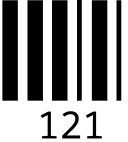 | Pharmacode | Discrete | Two | 藥品包裝(無國際標準) |
| PLANET | Continuous | Tall/short | 美國郵政服務(無國際標準) | |
| Plessey | Continuous | Two | 產品目錄,商店的貨架,庫存(無國際標準) | |
| PostBar | Discrete | 4 bar heights | 加拿大郵局 | |
| POSTNET | Discrete | Tall/short | 美國郵政服務(無國際標準) | |
 | RM4SCC / KIX | Discrete | 4 bar heights | 皇家郵政/PostNL |
| RM Mailmark C | Discrete | 4 bar heights | 皇家郵政 | |
| RM Mailmark L | Discrete | 4 bar heights | 皇家郵政 | |
| Telepen | Continuous | Two | 圖書館(英國) | |
 | 通用產品代碼 | Continuous | Many | 全球零售,-GS1批准的國際標準ISO/ IEC15420 |
矩陣(二維)條形碼
矩陣碼,也被稱為二維條碼或二維碼,是一种以二維矩陣呈现数字信息的方式。它類似於線性(一維)條碼,但可以表示更多數據。
| 例 | 名稱 | 註記 |
|---|---|---|
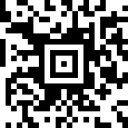 | Aztec碼 | Designed by Andrew Longacre at Welch Allyn (now Honeywell Scanning and Mobility). Public domain. – International Standard: ISO/IEC 24778 |
| Code 1 | Public domain. Code 1 is currently used in the health care industry for medicine labels and the recycling industry to encode container content for sorting.[2] | |
| ColorCode | ColorZip[3] developed colour barcodes that can be read by camera phones from TV screens; mainly used in Korea.[4] | |
| Color Construct Code | Color Construct Code is one of the few barcode symbologies designed to take advantage of multiple colors.[5][6] | |
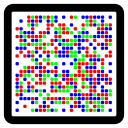 | CrontoSign | CrontoSign (also called photoTAN) is a visual cryptogram[7] |
| CyberCode | From Sony. | |
| d-touch | readable when printed on deformable gloves and stretched and distorted[9][10] | |
| DataGlyphs | From Palo Alto Research Center (also termed Xerox PARC).[11] Patented.[12] | |
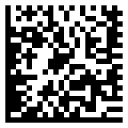 | Data Matrix | From Microscan Systems, formerly RVSI Acuity CiMatrix/Siemens. Public domain. Increasingly used throughout the United States. Single segment Data Matrix is also termed Semacode. – International Standard: ISO/IEC 16022. |
| Datastrip Code | From Datastrip, Inc. | |
| 128px | digital paper | patterned paper used in conjunction with a digital pen to create handwritten digital documents. The printed dot pattern uniquely identifies the position coordinates on the paper. |
 | EZcode | Designed for decoding by cameraphones;[15] from ScanLife.[16] |
 | High Capacity Color Barcode | Developed by Microsoft; licensed by ISAN-IA. |
 | Han Xin Barcode | Barcode designed to encode Chinese characters introduced by Association for Automatic Identification and Mobility in 2011. |
| HueCode | From Robot Design Associates. Uses greyscale or colour.[17] | |
| InterCode | From Iconlab, Inc. The standard 2D barcode in South Korea. All 3 South Korean mobile carriers put the scanner program of this code into their handsets to access mobile internet, as a default embedded program. | |
 | MaxiCode | Used by United Parcel Service. Now Public Domain |
| MMCC | Designed to disseminate high capacity mobile phone content via existing colour print and electronic media, without the need for network connectivity | |
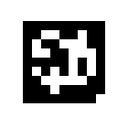 | NexCode | NexCode is developed and patented by S5 Systems. |
| Nintendo e-Reader#Dot code | Developed by Olympus Corporation to store songs, images, and mini-games for Game Boy Advance on Pokémon trading cards. | |
 | PDF417 | Originated by Symbol Technologies. Public Domain. – International Standard: ISO/IEC 15438 |
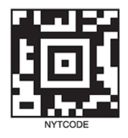 | Qode | American proprietary and patented 2D barcode from NeoMedia Technologies, Inc.[16] |
 | QR code | Initially developed, patented and owned by Toyota subsidiary Denso Wave for car parts management; they have chosen not to exercise their patent rights. Can encode Japanese Kanji and Kana characters, music, images, URLs, emails. De facto standard for Japanese cell phones. Also used with BlackBerry Messenger to pickup contacts rather than using a PIN code. These codes are also the most frequently used type to scan with smartphones. Public Domain. – International Standard: ISO/IEC 18004 |
 | ShotCode | Circular barcodes for camera phones. Originally from High Energy Magic Ltd in name Spotcode. Before that probably termed TRIPCode. |
 | SPARQCode | QR code encoding standard from MSKYNET, Inc. |
| VOICEYE | Developed and patented by VOICEYE, Inc. in South Korea, it aims to allow blind and visually impaired people to access printed information. It also claims to be the 2D barcode that has the world's largest storage capacity. |
参考文献
^ 《蘋果日報》:條碼發明人因病過世 享壽91歲,2012年12月14日
^ Adams, Russ. 2-Dimensional Bar Code Page. 15 June 2009 [2011-06-06]. (原始内容存档于7 七月 2011). 请检查|archive-date=中的日期值 (帮助)
^ Colorzip.com. Colorzip.com. [2011-11-28].
^ Barcodes for TV Commercials. Adverlab. 31 January 2006 [2009-06-10].
^ About. Colour Code Technologies. [2012-11-04]. (原始内容存档于2012-08-29).
^ Frequently Asked Questions. ColorCCode. [2012-11-04].
^ CrontoSign Image, Cronto .
^ Neu bei comdirect: photoTAN [New at comdirect: photoTAN], Comdirect Bank Aktiengesellschaft, 9 April 2013 (德语) .
^ d-touch topological fiducial recognition, MIT, (原始内容存档于2008-03-02) .
^ d-touch markers are applied to deformable gloves, MIT, (原始内容存档于2008-06-21) .
^ See Xerox.com for details.
^ DataGlyphs: Embedding Digital Data. Microglyphs. 2006-05-03 [2014-03-10].
^ "DataGlyph" Embedded Digital Data. Tauzero. [2014-03-10].
^ DataGlyphs. Xerox. [2014-03-10].
^ Scanbuy. [2011-11-28].
^ 16.016.1 Steeman, Jeroen. Online QR Code Decoder. [9 January 2014]. (原始内容存档于2014-01-09).
^ BarCode-1 2-Dimensional Bar Code Page. Adams. [2009-06-10]. (原始内容存档于2008-11-03).
外部連結
- EAN国际条形码会员国列表
- 在线条码生成
- 希创技术
- 在线条形码生成
参见
- QR碼
| ||||||||||||||||||||||||||||||||||||||||||||
| ||||||||||
|



Comments
Post a Comment